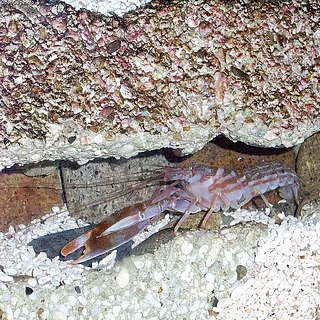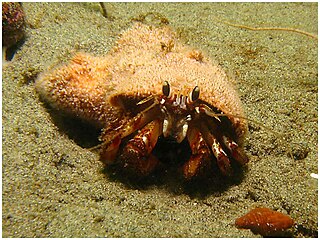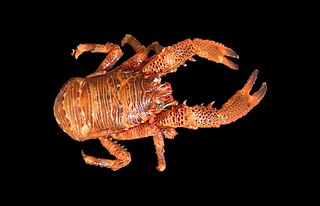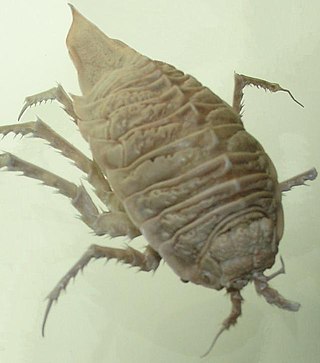
The Decapoda or decapods are an order of crustaceans within the class Malacostraca, including many familiar groups, such as crabs, lobsters, crayfish, shrimp, and prawns. Most decapods are scavengers. The order is estimated to contain nearly 15,000 species in around 2,700 genera, with around 3,300 fossil species. Nearly half of these species are crabs, with the shrimp and Anomura including hermit crabs, porcelain crabs, squat lobsters making up the bulk of the remainder. The earliest fossils of the group date to the Devonian.

The signal crayfish is a North American species of crayfish. It was introduced to Europe in the 1960s to supplement the North European Astacus astacus fisheries, which were being damaged by crayfish plague, but the imports turned out to be a carrier of that disease. The signal crayfish is now considered an invasive species across Europe, Japan, and California, ousting native species there.

The Parliamentary Secretary to the Treasury is the official title of the most senior whip of the governing party in the Parliament of the United Kingdom. Today, any official links between the Treasury and this office are nominal and the title of the office can be seen as a sinecure that allows the incumbent to draw a Government salary, attend Cabinet, and use a Downing Street residence, traditionally 12 Downing Street.

Siphonostomatoida is an order of copepods, containing around 75% of all the copepods that parasitise fishes. Their success has been linked to their possession of siphon-like mandibles and of a "frontal filament" to aid attachment to their hosts. Most are marine, but a few live in fresh water. There are 40 recognised families:

Alpheidae is a family of caridean snapping shrimp, characterized by having asymmetrical claws, the larger of which is typically capable of producing a loud snapping sound. Other common names for animals in the group are pistol shrimp or alpheid shrimp.

Solomon Alexander Hart was a British painter and engraver. He was the first Jewish member of the Royal Academy in London and was probably the most important Jewish artist working in England in the 19th century.

The Ocypodoidea, or ocypoid crabs, are a superfamily of crabs, named after the genus Ocypode. It contains over 300 extant species in these eight families:

The Hyperiidea are a suborder of amphipods, small aquatic crustaceans. Unlike the other suborders of Amphipoda, hyperiids are exclusively marine and do not occur in fresh water. Hyperiids are distinguished by their large eyes and planktonic habitat. Most species of hyperiids are parasites or predators of salps and jellyfish in the plankton, although Themisto gaudichaudii and a few relatives are free-swimming predators of copepods and other small planktonic animals.

Trypaea australiensis, known as the (marine) yabby or ghost nipper in Australia, or as the one-arm bandit due to their occasional abnormally large arm, and as the Australian ghost shrimp elsewhere, is a common species of mud shrimp in south-eastern Australia, the only species in the genus Trypaea. T. australiensis is a popular bait used live or frozen by Australians targeting a range of species. It grows to a length of 6 centimetres (2.4 in) and lives in burrows in mudflats or sandbanks, especially in or near estuaries.

The Diogenidae are a family of hermit crabs, sometimes known as "left-handed hermit crabs" because in contrast to most other hermit crabs, its left chela (claw) is enlarged instead of the right. It comprises 429 extant species, and a further 46 extinct species, making it the second-largest family of marine hermit crabs, after the Paguridae.
Allorchestes is a genus of amphipods with relatively small gnathopods, in the family Dogielinotidae; it contains the following species:

Pagurus is a genus of hermit crabs in the family Paguridae. Like other hermit crabs, their abdomen is not calcified and they use snail shells as protection. These marine decapod crustaceans are omnivorous, but mostly prey on small animals and scavenge carrion. Trigonocheirus and Pagurixus used to be considered subgenera of Pagurus, but the former is nowadays included in Orthopagurus, while the latter has been separated as a distinct genus.

Palaemonidae is a family of shrimp in the order Decapoda. Many species are carnivores that eat small invertebrates, and can be found in any aquatic habitat except the deep sea. One significant genus is Macrobrachium, which contains commercially fished species. Others inhabit coral reefs, where they associate with certain invertebrates, such as sponges, cnidarians, mollusks, and echinoderms, as cleaner shrimps, parasites, or commensals. They generally feed on detritus, though some are carnivores and hunt tiny animals.

Palaemon is a genus of caridean shrimp in the family Palaemonidae.

Sapphirina, whose members are commonly known as sea sapphires, is a genus of parasitic copepods in the family Sapphirinidae.

Galathea is a genus of squat lobsters in the family Galatheidae. It is one of the largest genera of squat lobsters that in 2008 contained 70 species. Most species of Galathea live in shallow waters.

Sphaeromatidea is a suborder of isopod crustaceans.

Copilia is a genus of copepods in the family Sapphirinidae. The eyes in members of this genus have two lenses, arranged like those in a telescope.

The Chaetiliidae are a family of isopod crustaceans in the suborder Valvifera, comprising these genera:

Ceratothoais a genus of isopod ectoparasites of teleost fish, first described by James Dwight Dana in 1852. Infection by Ceratothoa can cause anaemia, lesions, growth retardation, emaciation, and mortality in their fish hosts.



















